VOL.53, NO. 1
The Bigger Picture: Hermeneutics of the Pull Out in the Resident Evil Live-Action Adaptations (2002-2016)
Jacopo Wassermann
Foreplay
By the umbrella term “video game adaptation,” one usually refers to the cinematic or televisual adaptation of videoludic intellectual property. It is a process that has received growing attention by scholars and audiences alike, also thanks to the success of recent productions such as Sonic the Hedgehog, The Witcher, The Last of Us and The Super Mario Bros. Movie, to name but a few.
So far, video game adaptations have been an inconsistent object of study, pigeonholed between the two key terms of remediation and convergence. Brooker hypothesizes that this may be due to the disreputable status of video games among other industrial-cultural forms: “The deliberate association with a lower-status form like video games brings a movie down to a trashier, edgier, funkier level; it sacrifices any claims to serious art” (124).
Flanagan argues that adaptation studies may provide video game studies with a methodology that would foster more meaningful interpretations of the medium (443). As early as 2004, game theorist Espen Aarseth defined similar propositions as examples of theoretical colonialism, preventing the study of video games on their own terms (54). Furthermore, it is telling that Flanagan does not focus significantly on feature films based on video games, defining them as “largely superficial” (444).
Meikle grapples extensively with the topic, but espouses a technologically deterministic view: “The leap from Resident Evil the game to Resident Evil the movie may have been somewhat less treacherous and somewhat more expectable than the leap from the rudimentary 8- or 16-bit Super Mario Bros. to the live-action Super Mario Bros.” (101). The author seems to imply that: a) video game adaptations ought to be mimetic; b) the more video games approximate (westernized, conventional, commercial) cinema’s mode of representation, the fitter they might be for adaptation. As a result, film adaptations of early games would necessarily be discounted, and newer ones would be lumped together under the same cinematic paradigm.
While sharing some of the aforementioned conceptual shortcomings, Leitch has more convincingly framed the abundant cinematic signifiers in video game adaptations as part of a rhetorical strategy devised by the filmmakers, aimed at circumventing cultural biases surrounding video games (271-272).
Elsewhere, I have made a case (also inspired by Leitch’s point) for reframing this kind of productions as adaptations of the cinematically inspired imagery contained within their source texts (“Debt Repaid” 63). This suggestion was motivated by a wish to move beyond essentialist claims on the allegedly antonymous nature of cinema and video games as media, as well as reductionist approaches that sought to completely streamline their distinguishing features and related conceptual models. In other words, to consider video game adaptations as something other than inconsequential absurdities or another instance of business-as-usual.
I now wish to expand on that initial hypothesis by considering a concrete historical example: the live-action movie series based on the video game franchise Resident Evil. The reasons for this choice are the following:
1) the Resident Evil franchise (or Biohazard, as it is known in Japan) has famously been informed by a plethora of cinematic horror fiction, including George A. Romero’s saga of the living dead. This is reflected in its subject matter (artificially-induced, monstrous mutations to organic life forms), as well as the cinematic flair of its character design, art direction and virtual camera (Hand 128). Romero himself directed an ad for the launch of Resident Evil 2, and was in talks to direct a feature adaptation that would eventually be helmed by Paul W. S. Anderson (Scott);
2) to date, the Resident Evil live-action movie series (“RE series” from now on) is arguably the most financially and critically successful attempt to elaborate a movie franchise based on a video game property. It is composed of the following features: Resident Evil, Resident Evil: Apocalypse, Resident Evil: Extinction, Resident Evil: Afterlife, Resident Evil: Retribution, and Resident Evil: The Final Chapter. Subsequent productions, such as the feature film Resident Evil: Welcome to Raccoon City and the Netflix-sponsored streaming series Resident Evil, as well as the animated features Resident Evil: Degeneration, Resident Evil: Damnation and Resident Evil: Vendetta, are narratively and stylistically extraneous to the RE series. Consequently, they are beyond the scope of this article;
3) due to its popularity, the RE series has benefited from a relatively larger critical literature (Farghaly 9-14) than other cases of video game adaptations;
4) its distinguishing policy of maintaining a rather free approach to the source material (and to its own, internally established dramaturgy) provided these productions with a greater range of staging possibilities. In other words, the RE series’ spectacle is largely unbound from that of the game series and, whenever overlaps do occur, they serve different purposes. These discrepancies are invaluable for the study of intermediality between cinema and video games, especially if one wishes to gain a greater clarity on their richly layered mediatic exchanges.
The aesthetic bond between cinema and video games is based on a widely shared perception that they are fundamentally visual media (Perron and Arsenault 28). I, therefore, wish to explore how the filmmakers handled the adaptation of one visual form into another. The staging choices made by the filmmakers would allow me to deduce an overall “adaptive strategy,” by which I refer to the accumulated attitudes and goals pursued by the adaptors, as evinced by their statements and/or finished work. I focus on the series’ cinematography, not only as an expression of film form, but also as a tool for adaptation. Of course, a wider analysis would have to consider the contribution of other departments, including but not limited to: art direction, wardrobe, props, lighting, etc. I privileged cinematography (in its wider sense of charting motion, regardless of any specific apparatus or technology) because it ultimately defines what is going to be seen and what is to remain invisible.
The preparatory task for this article was a visual analysis of the RE series, during which I looked for significant patterns in cinematography and shot breakdown. The visual analysis brought to my attention the persistent inclusion by the filmmakers of a trope which, I argue, is highly representative of the movie series’ approach to adaptation as a whole: the pull out.
By this term, I broadly refer to any backward movement seemingly performed by the movie image within the diegetic environment. By movie image, I refer to the finalized visual output of a movie, regardless of whether it was photo-chemically or digitally recorded, or even composited from different sources. To be sure, these are not technical definitions, but rather phenomenological ones. In this specific sense, the pull out encompasses many different techniques aimed at producing the effect of backward movement, such as: dollying, or physically moving the recording device on a track; zooming out, which constitutes an optical rather than a physical movement (if one doesn’t count the movement performed by, on and through the lens); compositing, through the juxtaposition of discrete movie images during post-production. The significance of this visual trope was suggested by its sheer frequency throughout the series (45 times, by my count), as well as the aesthetic and technical features of the pull out itself.
In the next section, I shall detail my methodological approach, informed by a number of recent studies of cinematic movement and film hermeneutics. If one is to conduct a comparative study of the means of representation available to cinema and video games, due attention has to be paid to matters of form and style in both media, which possess highly distinct terminologies and theoretical frameworks. I argue that a combined recourse to descriptive methodology and hermeneutics can duly problematize their relationship, allowing us to navigate and properly address it.
Consequently, I will focus on the pull out as one such element that upends any superficial similarity between the aesthetics of cinema and video games, especially as it relates to the implied presence of the offscreen.
Finally, I will offer an interpretation of the pull out in the RE series, positing it as a cinematic technique that allows us to probe and question these films' uneasy relationship with the videoludic medium.
Sticky business: methodology as work-in-progress
Contrary to the cases of literary and theatrical adaptation, cinema and video games share the same sensible means (time-based screened representation), but must put them to vastly different ends. Moreover, shared means does not imply shared behavior. This posits a number of methodological challenges to scholars of all backgrounds.
Formalist accounts of film style as popularized by Bordwell are very useful in my understanding of the concepts of movie image and pull out, as is his notion of cinematic movement: “Camera movement during filming is neither a necessary nor a sufficient condition for the perception of camera movement in the finished film. Some obvious examples would be process work or backdrops unrolling behind people walking on treadmills” (“Camera Movement” 20). As such, Bordwell adds, “camera movement could be described as a system of perceptual relationships” (“Camera Movement” 22).
Obviously, there are not only technical, but also stylistic and expressive differences between performing, say, a dolly or a zoom. Whether the movement is performed on analog or digital equipment may spur further considerations. However, according to Schonig: “Bridging motion forms across such disparate examples—from different kinds of represented phenomena, to different genres and modes of cinema, to even different media (analog and digital)—allows us to see ways of moving where we only saw representations, to see glimpses of repetition where we only saw difference” (5). In this sense, Schonig’s formulation of “motion forms” is virtually analogous to my use of the term trope, as well as being compatible with Bordwell’s understanding of “perceptual relationships”: “motion forms are determined by perceptual structures rather than ontological ones. They constitute a perceptible way of moving—a pattern, a structure, a shape, a whole—synthesized within a visual field of moving phenomena” (Schonig 3).
The pull out can therefore be thought of as a motion form, and its role in the RE series is the object of my inquiry. What is its meaning and purpose, not only as cinematic form, but as a strategy for transposing videoludic source texts? In other words: what does it mean to pull out in these movies? And what does that tell us about the larger issue of the comparative aesthetic relationship between cinema and video games?
This is the task where adaptation studies can prove particularly fruitful: not only in terms of accounting for the adaptive strategies between cinema and video games (useful in and of itself), but also, at a meta-theoretical level, in mediating between and promoting a greater understanding of their respective fields.
My understanding of adaptation studies as a meta-theoretical testing ground is informed by Cattrysse’s definition of a polysystem or descriptive methodology,
a research program that is induction-based to the extent that it is based on observation, and deduction-based to the extent that it is based on a pre-established theory. Hence a DAS [Descriptive Adaptation Studies] approach looks for answers that fit the (parts of) reality it investigates. Since the method is seen as either a means to an end or as a tool with a specific purpose (i.e. the identification, description, explanation of an object of study), the extent to which such a means enables researchers to achieve their goals is a measure of how well (parts of) its tools and (parts of) its structure can be applied, adapted and amended or replaced in order to obtain ever more reliable factual as well as conceptual knowledge about the object of study. (44)
Expanding on Cattrysse’s formulation, I believe such an approach would benefit a critical understanding of the process of inquiry, along with its object: that is, both the phenomenon of adaptation and that of conceiving the study of adaptation(s).
This draws an apparently paradoxical parallel between the empirical and object-driven theoretical approaches of the likes of Bordwell, Morgan, Schonig and Cattrysse, among others, and something closer to the subjective open-endedness of hermeneutic interpretation. Indeed, the word “hermeneutics” may well have been taken as an insult by Bordwell himself:
An interpretive school, I take it, asks the writer to master a semantic field informed by particular theoretical concepts and then to note certain features of films that fit that field. […] Every recognized “method” – phenomenological, feminist, Marxist, or whatever – follows something like this routine. They all aim to produce interpretations, which I take to be ascriptions of implicit or symptomatic meanings to texts. (“Poetics of Cinema” 12)
Instead of arguing against Bordwell’s legitimate concern, I will simply notice how hermeneutics may very well offer the solution rather than an umpteenth iteration of the problem.
Briefly put, textual hermeneutics, as developed by Paul Ricœur, are an a-systematic, open-ended method for interpreting symbols (dense communicative objects which stimulate a multiplicity of possible meanings) (Ricœur 31). Drawing from Ricœurian hermeneutics, Baracco sketched a hermeneutical model that charts the process of sense-making embarked upon by a film spectator. Central to this is the notion of film world, which is not a mere representation of a world, shot and recorded and then projected; rather, it always implies a construction of a (new) world—i.e., a world-making in which the filmgoer is directly involved and that is re-made in every film experience. (…) Thus, the concept of the film world sustains a relationship with the filmgoer which entails both an immersive, emotional and precognitive state and a more purely cognitive, interpretive and analytical one. (Baracco 71-72)
This results in a three-phased circuit: naïve understanding (based on an intuitive, present tense interpretation of the film world); in-depth explanation (based on a historically informed analysis of the symbols within the film world); and, finally, critical understanding (in which the spectator as interpreter becomes aware of their own processes of sense-making, potentially opening up new hermeneutical horizons). The hermeneutic circle, however, is not founded upon the sole interpretive subject: “hermeneutics should always seek to return to the things themselves, according to the main principle of phenomenology (…). Without such a continuing effort, hermeneutics risks closing itself in the useless vicious circle of the relativistic self-validation of those same premises” (Baracco 37).
At the risk of committing a gross oversimplification myself, I would call attention to the existence of a thread uniting all aforementioned authors and their respective inquiries. This thread is to be found in the word “description” and its corresponding model of an a-systematic research program founded on phenomena. Far from contradicting this unity, hermeneutics seeks to assess, question and analyze such recourse to description.
To be clear, I am not proposing that we consider film stylistics, poetics or descriptive methodologies as alternative versions of hermeneutics – nor does hermeneutics itself entail that, since “The hermeneutical investigation (…) is always in a dialogue with other possible interpretations of this shared perception and expression of the film world. Interpretation of the (film) world is never given in absolute terms as a complete, objective and a-temporal meaning; instead, it always requires other interpretations” (Baracco 55).
My analytical approach can thus be considered a hermeneutics of film style, performed upon the use of the pull out throughout the RE series.
Lumet remarked how critical considerations of style in cinema are often content with merely scraping its surface: “Discussions of style as something totally detached from the content of the movie drive me mad. Form does follow function – in movies too. […] Because that’s what style is: the way you tell a particular story” (Lumet 49-50). Consequently, one could not ascribe universal values and functions to any stylistic resource, including movement, since authorial intent and context can greatly affect them: “how camera movements work is not fixed by any essence but instead predicated on the range of norms, ideas, and uses that attend them” (Morgan 9).
Bordwell starts out in somewhat similar fashion, claiming: “There are no laws of stylistic history, no grand narratives unfolding according to a single principle”; but then hastens to add, “that does not prevent us from proposing explanations for long-term, middle-level trends of continuity and change” (“History of Film Style” 260-261).
From start to finish, the RE series encompassed 14 years of feature releases (2002 to 2016), which could rightfully be thought of as a middle-level time-span.I suggest that the persistent inclusion of the pull out throughout the series is due to the “norms, ideas, and uses” (Morgan 9) associated with that trope, situated at a high point of tension between cinematic and videoludic forms. In the next section, I will identify this tension as being predicated on the status of the offscreen, especially as defined and continuously reconfigured by the moving camera.
Safe words: double entendres along the disciplinary divide
Let us first consider the critical consensus on the formal and phenomenological properties of cinematic movement itself. Schonig observes how forward movement seems to foster a process of identification between spectator and camera: “Simulating what it’s like to face the world and move toward it, forward camera movements strongly evoke the familiar feeling that our intentional bodily movements will result in predictable changes in the visual array” (102). If that’s the case, one may ask: what about backward movement? Does the fact that it follows the same axis mean that we can consider it much in the same way? Or does it posit a rupture?
It is not easy to provide a consistent answer: in addition to the differing phenomenological properties of the movement, one has to account for historically and culturally located ideas concerning film form and its related practices. For example, if we were to consider the Classical Hollywood paradigm, most camera movements would seem ill-fitted to the demands of formal transparency. While they could be justified by certain elements in the diegesis (for example, tracking the trajectory of an actor in the proscenium), there are at least as many examples of diegetically extraneous movement. But then, how to account for the fact that many classical movies do feature overt camera movements?
Keating seeks to deflate the apparent contradiction: “For many Hollywood filmmakers, saying that a technique was invisible was a way of saying that the technique was functional, with irony included as a perfectly permissible purpose” (90). Said “irony” results in “a meaning that is available to spectators while remaining unavailable to the citizens of the fictional world” (Keating 85). To be sure, this is fundamentally true of any stylistic device. The difference is that camera movement makes “the play of revelation and concealment unusually salient. When the frame moves from left to right, a part of the storyworld glides offscreen, and another part of the world slides onscreen. […] To watch a dolly shot is to see the cinema’s selectivity in action” (Keating 110).
The inequality between observers and filmmakers is especially important when it comes to motion forms, because, as a spectator: “The changes, moreover, are out of my control: I am moved through the world but am myself unable to effect such displacements, a radical dissociation of cinematic point of view from ordinary forms of perception” (Morgan 62).
If transparency is ultimately arbitrary and context-dependent; if motion forms are untethered to human perception; if the spectator is but an ironic participant in cinematic spectacle: camera movement should not, by rights, hold any special status in the aesthetics of cinema, nor should there be any reason to consider forward or backward movement different from one another. But it does, and there is.
Regarding the camera-spectator paradox, I might be forgiven for pointing out how, once again, film hermeneutics proves itself up to the task:
the filmgoer can perceive an act of perception as implicitly referring to a perceptual unity, which is related to the film world and placed within it. This perceptual unity corresponds neither to the body of the film’s protagonist nor to any other film character, nor even to a narrator who recounts the course of events. Rather, it is something that is perceived by the filmgoer as always behind what is presented but still inside the film world. This perceptual unity is correlated by the filmgoer to the film world and perceived, therefore, as the unity of the expressed film world. (Baracco 49)
Keating and Morgan both envision similar solutions to the conundrum: the former calls it “participatory camera [which] shares in the characters’ emotions not by representing their perceptions, but by imitating their affective gestures” (Keating 113); the latter opts for an “internal spectator [who] creates a refraction of sorts, splitting the beam that connects the viewer to the film world into different spectatorial positions dispersed within the image” (Morgan 81).
The aforementioned participatory model of spectatorship may lead (and indeed has led many) to assume an affinity with generative, pro-active modes of vision typical of digital media, such as video games. One should take great care with such comparisons.
For starters, “the videogame camera is, in no real sense, a camera [and] it is not bound to produce images according to the physical, optical properties of light cast by objects and recorded through a lens or aperture” (Thomas and Haussmann 1-2). It might be more useful to think of it as a projector rather than a recording equipment, since game cameras “must specify a number of properties regarding the position and orientation of the viewpoint within the game world. More important, the presentation style dictates how the game world is projected (or rendered) onto the display device” (Haigh-Hutchinson 26). Of course, game cameras can be programmed to mimic the conventions of optical photography, and in that sense, “the difference between game cameras and real-world cameras is rapidly decreasing. […] It is relatively commonplace for entire films to be post-processed to change lighting conditions, remove film stock blemishes, insert digital characters, and so forth” (Haigh-Hutchinson 23).
Perhaps unsurprisingly, the RE game series attracted considerable critical attention because of the cinematic presentation style of some of its entries, namely: Resident Evil (Capcom [PlayStation version]), Resident Evil 2, Resident Evil 3: Nemesis, Resident Evil – Code: Veronica, as well as the remake Resident Evil (Capcom [GameCube version]) and the prequel Resident Evil Zero. With the exception of Code: Veronica, the presentation style of all the other titles was based on pre-rendered backgrounds, which can best be thought of as an instantaneous matte effect: the only dynamic elements are the player’s avatar, scripted non-player characters, and a limited number of objects; the surrounding environment is purely decorative, permitting a small range of movement.
All of them (Code: Veronica included) resorted to fixed camera angles, whose succession is determined by the activation of embedded hot-spots. The overall effect is superficially akin to a movie sequence playing out before the player’s eyes, albeit one that requires their physical, conscious effort (the commands transmitted through an input device) and is liable to be interrupted by any number of factors (the eventuality of a game over, the necessary navigation of in-game maps, files and menus, etc.). Let us briefly consider a game event from the first installment by way of example.
As the player is exploring a secluded mansion, they will eventually reach the so-called “L passage,” a corridor with a single 90º turn located on the southeastern corner of the first floor. Each end of the corridor has a door leading to other locations. This part of the map is covered by four camera views: two are directed at the doors, while the remaining two show the 90º turn from opposite corners. As the player moves the avatar towards designated hotspots, the view switches automatically to the next one, as such: door, corner, corner, door. This breakdown allows the player to keep their avatar in view at all times, aiding them in traversing the corridor from one end to the other.
On their first visit only, there will be two additional hotspots located in the corner views. As the avatar steps past a certain point in the first corner view, a ravenous dog will break through a window in the foreground and chase the player, attacking without break (see Figure 1). A second dog will break through a different window if the avatar steps onto the other, invisible hotspot, located in the second corner view. The views are set so that the player may glean no useful vantage point ahead of time. Effectively, one could say the dogs are located offscreen, waiting to ambush the avatar at any given moment.
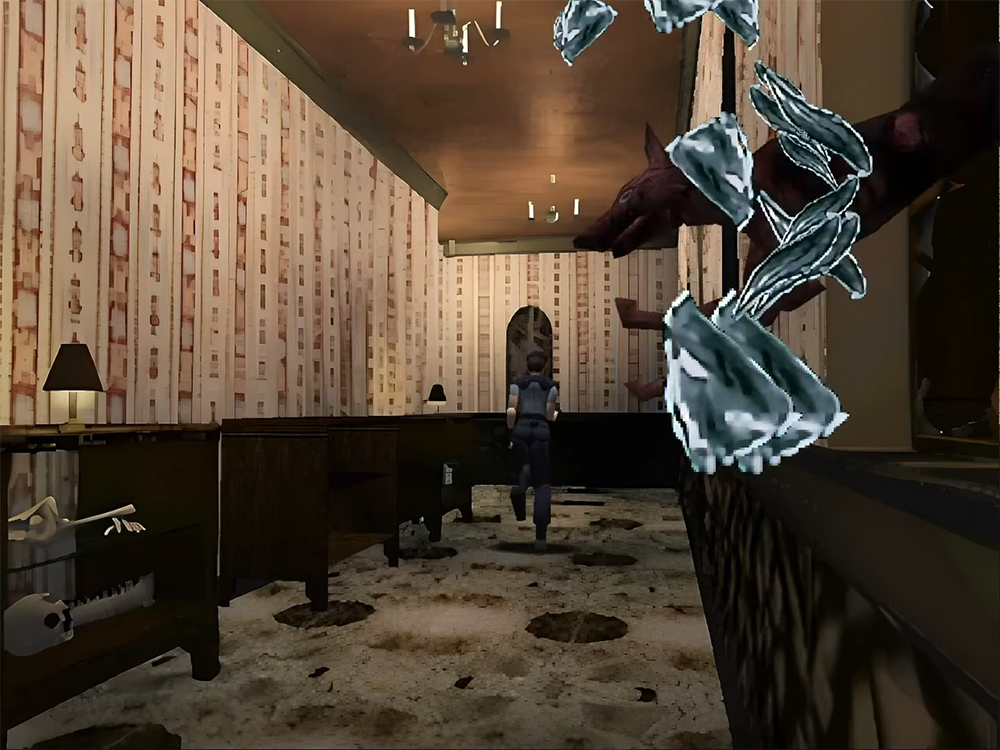
However, that is only an ably mounted illusion: the polygonal models of the dogs and shattered glass are loaded on the spot upon triggering the hotspot, as there is no “out there” from whence they came. Every digital environment, or map, is loaded progressively as necessity arises, and there is literally nothing outside of it.
If there is something like a videoludic offscreen, it mostly exists in the minds of players and holds a primarily strategic function: for example, memorizing a map’s outline for better orientation, or figuring out the solution to puzzles that require interaction in separate locations. One could make the point that offscreen also occurs during cut-scenes, that is, non-interactive sequences that can be either pre-rendered or calculated in real time by the game’s engine, often recurring to preset editing choices (Cheng 16). However, the timing of the cut-scenes themselves often depends on prompts by players, such as the time they take reaching a certain hot-spot, or whether they simply decide to skip them (provided they can) in the interest of a higher playing time – again, something very different from the ordered editing of a movie (Boyer 102).
Considering all this, the insistence on including several instances of pull out throughout the RE series seems less and less accidental. Having been tasked with the adaptation of a game series heavy in cinematic signifiers, the filmmakers opted for visual strategies that played to their own medium’s specificity.
From what I’ve been outlining thus far, the power of the pull out can be said to derive from a conceptual subversion of classic models of cinematic spatial representation, including the famed principles of transparency and the 180º rule. The pull out threatens to subvert both by reframing the edges of the known film world, doing so by retreating further into the “forbidden zone” that belongs to the device. Therefore, it is both a noticeable movement and one that has the power to redraw and/or reveal the imaginary line. By contrast, the pull in would not be an equally disrupting movement, precisely because the movie image advances further and further in an already established ‘spectacle zone.’
Whether classic aesthetic norms still apply in contemporary Hollywood production is a matter of debate. However, it’s interesting to note that Bordwell, a historian of film style, refuses any rigid distinction: “Far from rejecting traditional continuity in the name of fragmentation and incoherence, the new style amounts to an intensification of established techniques. Intensified continuity is traditional continuity amped up, raised to a higher pitch of emphasis” (“Way Hollywood Tells It” 120). For example, one may observe that pulling out (or pulling back) was a fairly common way to bookend a scene or a sequence in the “classic style,” suggesting closure through distance.
Furthermore, I do not wish to deny that a pull in can also be surprising, or revealing. It merely fits a different purpose. The pull in usually aims at showing us something that was already located within the field of view from the start, perhaps hidden by some sort of physical or perceptual obstacle. Conversely, the pull out might aim at showing us something new, challenging our initial assumptions by heading out into previously uncharted space. What Schonig says of lateral camera movements may well apply here: “while we can anticipate the direction of the space that passes before us, the space isn’t so much anticipated as unfurled, as if spontaneously generated from the edge of the window” (104).
The pull out draws power from its peculiar relationship with the offscreen. We can refer to the offscreen in a strictly technical, material sense, as in, everything that is left out of frame during the act of shooting (actors, props, crew members, technical equipment, natural features, etc.). However, offscreen as a concept encapsulates much more than that: it is not merely a distinction to determine what is filmed and what is not, but, perhaps most importantly, an imaginative extension of the film world whose contours are only sketchily established by a movie’s découpage. This space, being imaginative, can never be exhaustively represented, since the movie image always depends on a frame that is necessarily limited.
The pull out intersects and interacts with the offscreen in a more unsettling way than the pull in, because, as already mentioned, it threatens to reveal the apparatus responsible for the film spectacle. The ending of The Holy Mountain is a literal illustration of this threat: the character of the Alchemist, played by director Alejandro Jodorowsky himself, breaks the fourth wall by commanding the camera operator to zoom out. The operator promptly obeys, and the spectators are served with a wider view that includes the film crew (see Figure 2). The director then exhorts the audience to break free of the cinematic spell and head out to the real world.
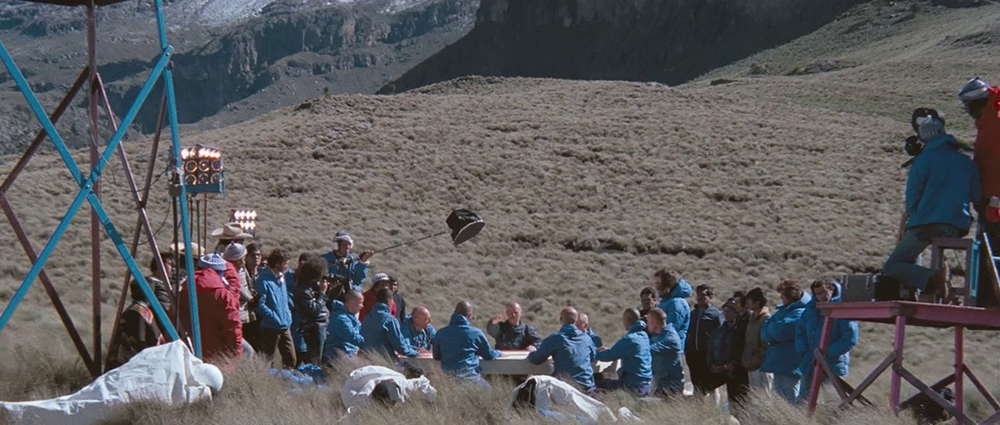
The paradox is that the pull out was obviously staged and prepared beforehand, as the shot’s balanced final composition will attest. Who and where is the camera operator that is obeying the director’s command? They are obviously not included in the revelatory frame – and how could they be, since they are filming on the device that allows these pictures to exist in the first place? That is why Jodorowsky cannot content himself with this meta-cinematic move, and has to double down with an invitation to leave the film space for the real world: otherwise, the revelatory power of the zoom out wouldn’t hold, and the movie’s representation would be stuck on the plane of spectacle that the shot is meant to disassemble. In other words, spectacle and offscreen go hand in hand, and the pull out rides on their porous demarcation line.
It is in the ongoing backward movement that the pull out achieves its greatest tension: in spite of the impossibility of ever crossing the line into the device zone, the trajectory heads into that direction. Once it reaches its destination, the pull out settles back into spectacle, albeit one that may retroactively inspire a more self-conscious perception.
Let us finally consider how this motion form factors in the RE series’ adaptive strategy.
Pull out: a risky maneuver
The following is a synthetic recap of the RE series’ narrative outline, meant to aid unfamiliar readers as well as contextualize the formal choices made by the filmmakers.
Alice (played by Milla Jovovich) is an operative hired by the Umbrella Corporation, who is on a quest to unveil her employers’ shady business practices. Umbrella has been conducting research into bio-weapons, eventually manufacturing the T-virus, which has the power to resuscitate dead organic matter. However, the virus also provokes genetic mutations, and turns the infected into violent, murderous creatures. Throughout the course of the series, the T-virus gets out of containment and provokes an apocalypse. Alice learns that she is yet another company asset, having been cloned from Alicia Marcus (also Milla Jovovich), the terminally ill co-owner of Umbrella. With Alicia’s help, Alice manages to retrieve a cure for the T-virus and destroy Umbrella once and for all.
This narrative trajectory is only loosely based on the source material’s dramatic events and characters. The main character, Alice, is an original contribution to the canon, while the games’ recognizable leads are often relegated to secondary roles. However, both series share a fundamental concern with the unchecked power of corporate liberalism and the ethics of scientific research.
In spite of some occasional changes in the creative team, the RE series features recurrent and recognizable stylistic choices, chief among them the abundant use of the pull out. On the whole, I distinguished at least 45 instances in which the image pulls out through a variety of technical means: zoom (both optical and digital), dolly, steady cam, crane, helicopter, and through the use of virtual camera, among others. The move is most present in Resident Evil: Retribution (11 times), while Resident Evil: Apocalypse features it the least (only twice). There is a significantly higher number of occurrences in the second trilogy (Afterlife: 7 + Retribution: 11 + The Final Chapter: 9 = 27) than in the first one (Resident Evil: 7 + Apocalypse: 2 + Extinction: 9 = 18). It bears noting that Resident Evil: Afterlife marked a switch from analogue to digital image, which might have facilitated the necessary workflow to pull out through the aid of CGI and compositing. Glen MacPherson, who acted as cinematographer in the second trilogy, declared that, while Afterlife was burdened with cameras tethered to separate recording stations, Retribution and The Final Chapter benefited from newer, mobile equipment that facilitated the staging of complex action scenes (Sweeney).
During the visual analysis, I recorded each recognizable instance of a pull out, noting its location, time code, duration, technique (ascertained or presumed), and narrative content. The resulting grid would be too long to include here: the following is an example based on the climactic closing shot of the first installment (see Table 1) (see Figure 3 and Figure 4).
Table 1
Resident Evil’s Last Pull Out
Resident Evil (2002) Director: DOP: NTSC Blu-Ray |
01:33:27 – 01:34:02 |
34s21 |
Camcat System |
From extreme close up to extreme long shot, Alice faces a destroyed and desolate landscape of Raccoon City. |
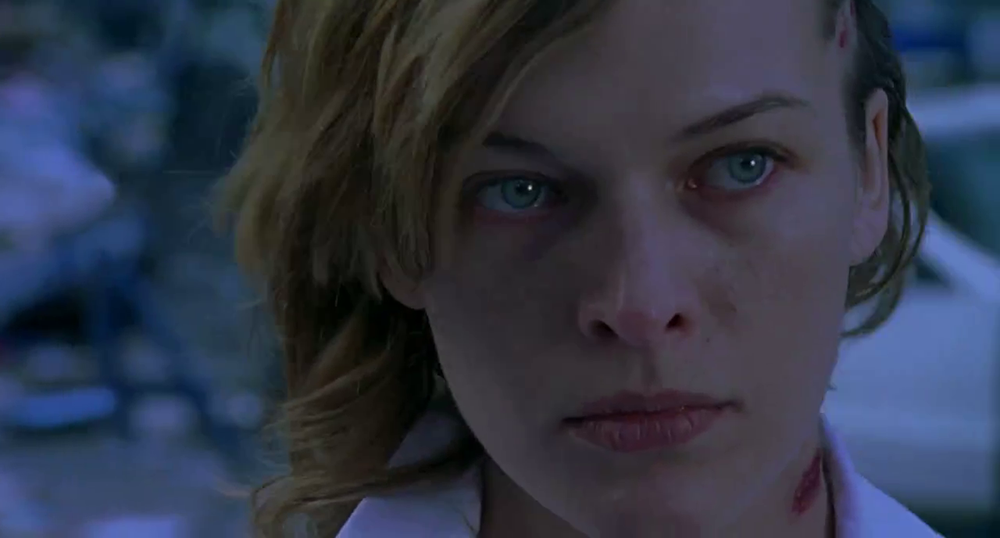
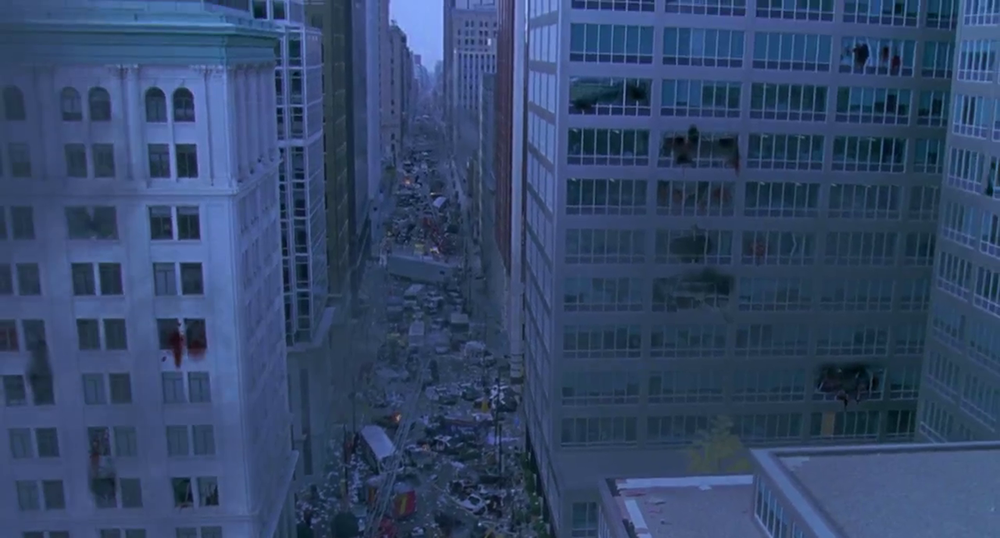
These data, when systematized throughout the series, allow us to track privileged techniques by the filmmakers, as well as the frequency, length and narrative beats underlying the shots. In this case, the technique was ascertained thanks to the inclusion of a making-of in the home video release of the movie. At other times, it was necessary to resort to guesswork based on the visual evidence of the pull out.
However, I also wished to formulate a hypothesis as to what function the movement was fulfilling, according to Cattrysse’s definition: “In PS [polysystem]-speak, the word ‘to function’ is redefined as to be presented and/or perceived as X within a specific space-time context” (12). Going back to the hermeneutical process, the formulation of this hypothesis, or working interpretation, could be thought of as a passage from naïve to in-depth understanding. I, thus, identified four main functions performed by the pull out throughout the RE series:
a) decorative flourish: whether a formal feature can ever be anything other than a flourish is a matter for debate, as was already observed. The term “flourish” would then imply an option in which style for its own sake trumps both communicative and pragmatic concerns. In Resident Evil: Extinction, a zoom out is coupled with an aerial view of Alice riding a bike in the desert, an aesthetic flourish that’s meant to provide an establishing shot of her trajectory through the diegetic environment (see Figure 5).
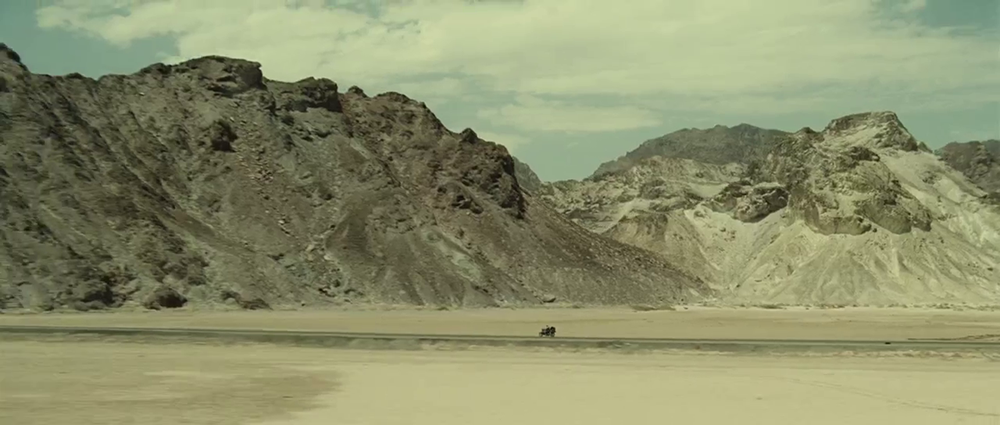
Any number of technical choices could have achieved the same end. In this case, the zoom out is not revealing anything other than a wider perspective on a location, and changes little to nothing in our understanding of the film world from its first to last frame;
b) representing instances of control and surveillance: this function refers to every instance in which the pull out signals the superiority of the image device (the intermediary that is supposed to have captured the images that compose the movie) in relation to the film world. The penultimate pull out in Resident Evil, a dolly, shows Alice from the other side of a one-way glass. As she starts slamming on the glass, yelling to be let out of her containment cell, the camera pulls back, showing an empty CCTV control room. Multiple screens display live video feeds filmed from inside Alice’s cell. Suddenly, a human silhouette crosses the shot, coupled with a menacing growl (see Figure 6).
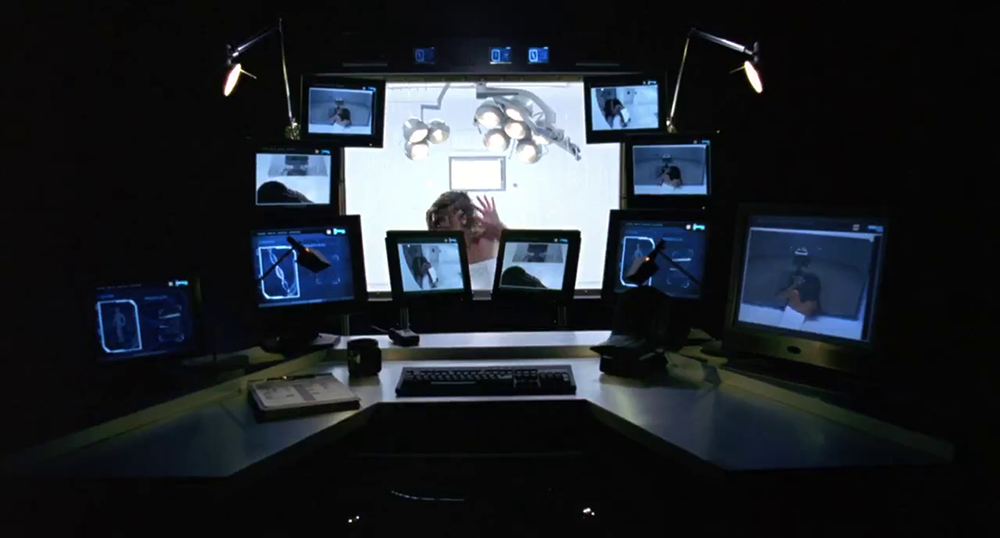
The choices in sound mixing are not by accident: other than setting up a final scare, Alice’s silenced yells plant our feet firmly in the CCTV control room. Even though the camera movement is not identified with that of any explicit agent (neither the CCTV cameras nor the zombie), its perspective is clearly in line with the purposes of the control room;
c) identification with diegetic non-human agents: the distinction between human and non-human agents is in itself ambiguous, especially in a fictional universe so evidently obsessed with technologically-altered life forms. For the purposes of my analysis, the distinction is strictly material: that is, whether the identification occurs with a human actor or some other kind of agent (inanimate, digitally-rendered imagery, etc.). This function is usually associated with diegetic surveillance systems: most notably, a fictional AI character called Red Queen. In these instances, the film image literally takes the perspective of diegetic CCTV devices onto the film world, displaying all sorts of additional data being processed by the Red Queen (location, risk assessment, etc.) (see Figure 7).
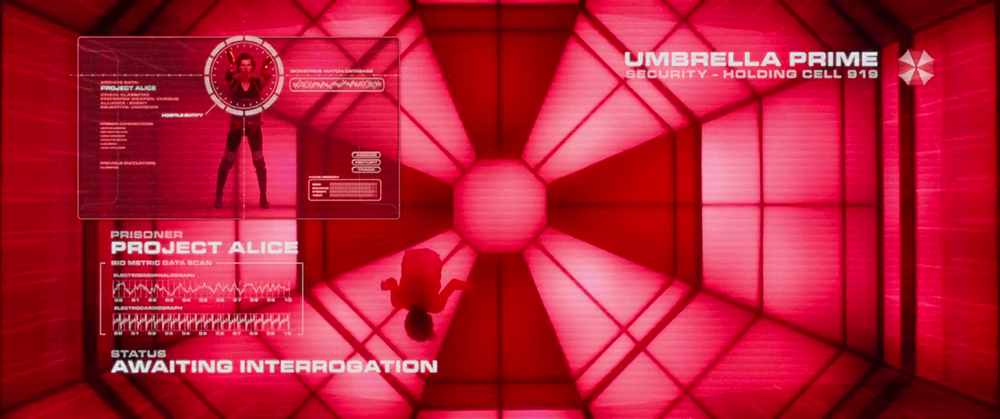
On the one hand, this choice is perfectly coherent with the pull out’s inherent superiority to the human subject’s gaze, doubling down on its power by enacting it through a diegetic, non-human agent. On the other, it helps to counter-balance the pull out’s opaqueness, assigning it to a fictional framing that safeguards the spectator’s immersion in the cinematic spectacle;
d) identification with diegetic human agents: this function does not supplant the superiority of the image device in relation to human characters. On the contrary, it is only through its intercession that subjects are granted expression. This function is mostly executed in moments of reversal, mirroring the characters’ acknowledgment of a new or surprising state of affairs. Each installment in the series (with the pointed exception of The Final Chapter) ends on an extended pull out, performed by a variety of wire or crane-based rigs with additional CGI work. These elaborate shots depict surprising and dramatic reversals, usually worsening the odds of the main characters in their struggle against Umbrella. It is also a clear example of internal reference and branding, since chapters 2 (Apocalypse) to 5 (Retribution) all reprise and elaborate on the above-mentioned first film’s closing shot, in which Alice escapes her containment only to find the fictional setting of Raccoon City overrun by the T-virus (see Figure 4).
My formulation of these functions should make clear that their attribution is far from clear-cut. The first pull out in Resident Evil: Extinction is an apt example of such ambiguities. The shot starts by tracking a couple of lab technicians as they carry the lifeless body of an Alice clone (see Figure 8).
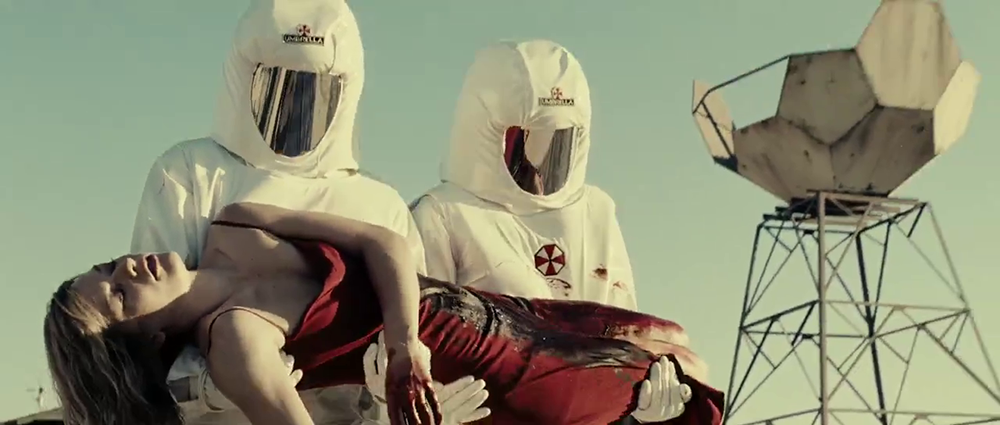
At this point, the camera is identifying with their movement, thus performing function d). As they unceremoniously dump the body in an open grave, the camera follows its fall and pulls back, following a trail of dead clones. The bodies all show the likeness of actress Milla Jovovich, whose image was digitally composited multiple times in order to create an illusion of continuous, unbroken movement (see Figure 9).
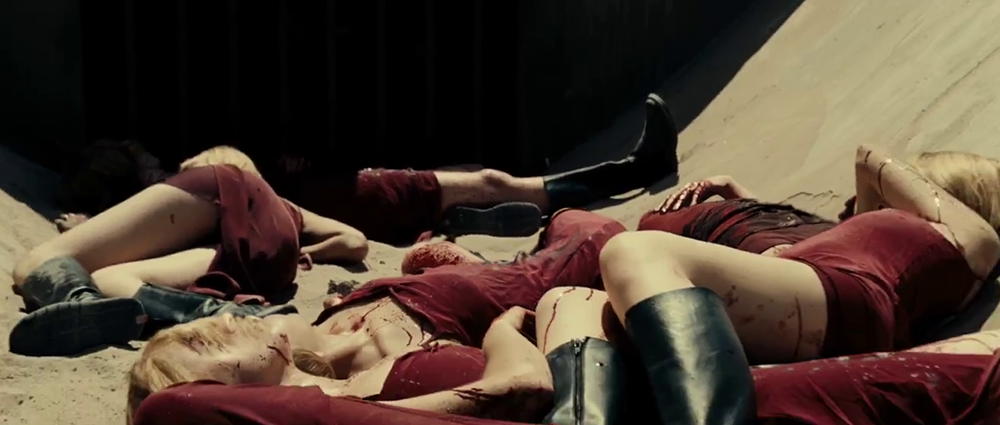
One could argue that the viewer is meant to empathize with the fate of these clones, but the camera is not identifying with anyone’s perspective or agency, since these characters are all dead. Also, while it’s true that each individual clone is played by Milla Jovovich, their co-existence in the shot is only made possible by digital compositing. In short, the camera switches to something of an inhuman perspective, whose disturbing effect was already commented on by Stone: “It is a scene redolent of necrophilia, the sexually desirable corpse laid out for our gaze” (134).
Finally, the camera pulls back through a fence (again, thanks to a digitally-aided transition) and shows a horde of zombies amassing around Umbrella’s complex (see Figure 10).
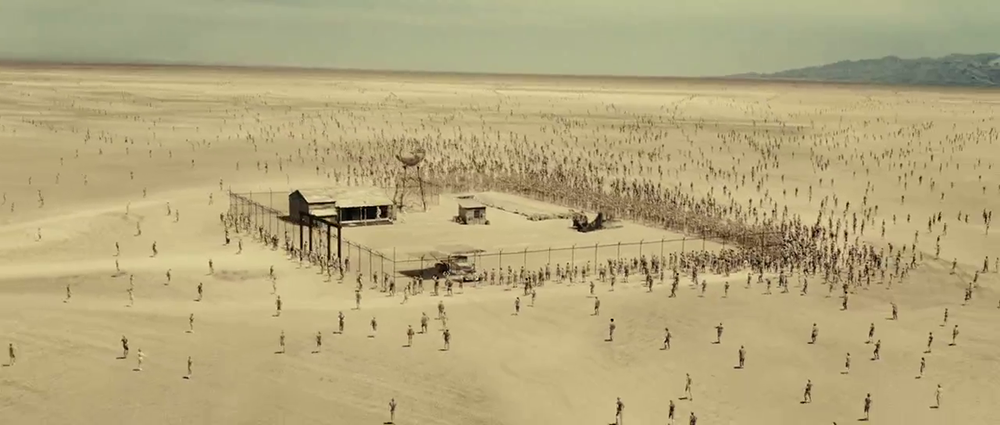
Here the camera can be said to identify with the perspective of the infected, some of them being played by actors in prosthetics. However, following standard practice in the industry, their ranks are amplified through digital multiplication, thus determining a co-existence of human and non-human agents.
Consequently, the pull out’s function is ambiguous and open to interpretation. Is it an indictment of the consequences of unethical scientific practices, leading to moral and material catastrophes? Or is it a tasteless aestheticizing of the female body and death? In this case, functions a), c) and d) may simultaneously be in play (see Table 2).
Table 2
Resident Evil: Extinction’s First Pull Out.
Resident Evil: Extinction (2007) Director: DOP: NTSC Blu-Ray |
00:05:58,11 – 00:06:38,05 |
39s19 |
Dolly, |
Lab technicians dump a clone’s body into open grave, as zombie horde surrounds desert complex. |
a) stylistic and/or aesthetic flourish c) identification with diegetic non-human agent d) identification with diegetic human agent |
There are also frequent overlaps between functions b) and c), as the image may identify with diegetic non-human agents (namely, cameras) that simultaneously represent instances of control and surveillance. That is obviously the case when the movie image displays recordings and renderings processed by the Red Queen AI character.
Decorative factors may be considered to be always present, if not necessarily dominant, while function d) is in some way dependent on the intercession of the image device as implied by function b), although in varying degrees of subordination (hence its absence from our analysis of Extinction’s first pull out).
All of this goes to prove the dense and layered nature of the pull out as a motion form, requiring an interpretive, provisional and contextual approach to probe its formal and communicative features.
Happy ending: a fitting conclusion
This article aimed at drawing attention to some of the formal resources used by filmmakers who work on video game adaptations, as well as outlining a theoretical and analytical approach adequate to these productions’ features.
In the case of the RE series, I argue that the pull out served as a tool to work through the source material’s underlying themes of corporate control and ethical hazard, as well as exploiting its opaqueness as a cinematic visual trope to prompt a more self-aware perception by the spectators. This state of self-awareness, in both form, content and consumption, could then be thought of as an alignment of the cinematic and gaming apparatuses, adding another layer to the adaptation performed by filmmakers.
The study suffers from several shortcomings that will need to be addressed through further refinement and the contribution by other willing scholars.
First of all, this is a mostly exploratory and qualitative attempt at performing a hermeneutics of film style, based on a handful of historical examples. More research should be done on the history of backward movement, as well as on any existing, relevant literature. In the absence of a monograph on the topic, contextual information should be gleaned from critics, scholars, production files, etc. The work carried out by Keating, Morgan and Schonig offers an encouraging blueprint, as do Hall’s study of the zoom and Doane’s recent publication on the history of the close up.
Secondly, it would have been preferable, following Bordwell’s lead (“History of Film Style” 4-5), to contextualize the pull out further in its historical, aesthetic and industrial spectrum. For example, both Barker and Stewart identify a motion form they call “cosmic zoom,” amounting to “a technique of digital rhetoric capable of drastic shifts in scale—as when plummeting from a satellite-range scan to a facial close-up, or lifting back out again—that also appears lately, in muted variants, for such radical shifts (in temporal rather than spatial orientation) as a precipitous tunneling from present into biographical past” (“Framed Time” 283). This definition could equally apply to some of the most outlandish pull out movements in the RE series, opening up a whole new inquiry into its wider cinematic referents.
Stewart also speaks of “surveillance cinema,” a genre where “the drama of recon, surveillance, and remote targeting—translated from desert combat to paramilitary CIA complots—is what the new protagonist must defeat, but only by beating it at its own game” (“Surveillance Cinema” 5). Again, the RE series is in many aspects part and parcel of that trend, and more could be said of its specific treatment of those themes.
Finally, as shown by the previous section, it is exceedingly difficult to offer a consistent interpretation of any function played by a motion form, or, in this case, the pull out. Two of these functions were said to result in an ‘identification’ with either a human or non-human agent. However, that is at best “an epistemic fantasy, one of being granted access to the film world in a way that is in fact impossible to achieve” (Morgan 5). Another was said to be representative of the theme and act of surveillance, but that function, along with the decorative one, can be thought of as inescapable components of the movie image in and of itself. These attributions are therefore context-dependent and hardly transferable. Another observer might very well reach different interpretations moving from the same visual evidence.
However, I hold that these limitations do not invalidate the enterprise as a whole. If anything, they mark nothing more than the temporary completion of the hermeneutic circle, resulting in a critical understanding that points the way to better-informed attempts at reaching knowledge – a little bit like grinding through subsequent game loops, until finally clearing the goal.
Acknowledgements (Special Thanks, etc.)
This work was supported by Fundação para a Ciência e a Tecnologia, based in Lisbon, Portugal (2022.11616.BD).
I wish to thank Julie Grossman, Kim Waale, Thomas Leitch, R. Barton Palmer and Seda Öz for their relevant feedback both during and after my presentation at the 2022 Literature/Film Conference.
Works Cited
Aarseth, Espen. “Genre Trouble. Narrativism and the Art of Simulation.” First Person: New Media as Story, Performance, and Game, edited by Noah Wardrip-Fruin and Pat Harrigan, The MIT Press, 2004, pp. 45-55.
Anderson, Paul W. S., director. Resident Evil. Constantin Film and New Legacy Film, 2002.
---. Resident Evil: Afterlife. Constantin Film, Davis Films and Impact Pictures, 2010.
---. Resident Evil: Retribution. Constantin Film, Davis Films and Impact Pictures, 2012.
---. Resident Evil: The Final Chapter. Screen Gems, Constantin Film, Davis Films and Impact Pictures, 2016.
Baracco, Alberto. Hermeneutics of the Film World. A Ricœurian Method for Film Interpretation. Palgrave Macmillan, 2017.
Barker, Jennifer M. “Neither Here nor There: Synaesthesia and the Cosmic Zoom.” New Review of Film and Television Studies vol. 7, no. 3, 2009, pp. 311-324.
Bolter, Jay David and Grusin, Richard. Remediation: Understanding New Media. The MIT Press, 1999.
Bordwell, David. “Camera Movement and Cinematic Space.” CinéTracts 2 vol. 1, no. 2, 1977, pp. 19-26.
---. On the History of Film Style. Harvard University Press, 1997.
---. The Way Hollywood Tells It. Story and Style in Modern Movies. University of California Press, 2006.
---. Poetics of Cinema. Routledge, 2008.
Boyer, Elsa. “Cut-scenes: L’Image Entrecoupée.” Voir les Jeux Vidéo: Perception, Construction, Fiction, edited by Elsa Boyer, Madeleine Ektypi, Elie During, Erwan Higuinen, Emmanuel Siety and Paul Sztulman, Bayard Editions, 2012, pp. 93-115.
Brooker, Will. “Camera-Eye, CG-Eye: Videogames and the “Cinematic”.” Cinema Journal no. 48, 2009, pp. 122-128.
Capcom, game developer. Resident Evil (PlayStation Version) [Video game], 1996.
---. Resident Evil 2 (PlayStation Version) [Video game], 1998.
---. Resident Evil 3: Nemesis (PlayStation Version) [Video game], 1999.
---. Resident Evil – Code: Veronica (Sega Dreamcast Version) [Video game], 2000.
---. Resident Evil (GameCube Version) [Video game], 2002.
---. Resident Evil Zero (GameCube Version) [Video game], 2002.
Cattrysse, Patrick. Descriptive Adaptation Studies: Epistemological and Methodological Issues. Garant, 2014.
Cheng, Paul. “Waiting for Something to Happen: Narratives, Interactivity and Agency and the Video Game Cut-scene.” Situated Play: Proceedings of DiGRA 2007 Conference, pp. 15–24. http://www.digra.org/wp-content/uploads/digital-library/07311.24415.pdf. Accessed 21 Jul. 2023.
Dabb, Andrew, creator. Resident Evil. Netflix, 2022.
Doane, Mary Ann. Bigger Than Life: The Close-Up and Scale in the Cinema. Oxford University Press, 2022.
Elsaesser, Thomas. “Digital Cinema: Convergence or Contradiction.” The Oxford Handbook of Sound and Image in Digital Media, edited by Carol Vernallis, Amy Herzog and John Richardson, Oxford University Press, 2013, pp. 13-44.
Farghaly, Nadine. “Introduction: Unraveling the Resident Evil Universe.” Unraveling Resident Evil. Essays on the Complex Universe of the Games and Films, edited by Nadine Farghaly, McFarland & Company, 2014, pp. 9-14.
Flanagan, Kevin M. “Videogame Adaptation.” The Oxford Handbook of Adaptation Studies, edited by Thomas Leitch, Oxford University Press, 2017, pp. 441-456.
Fowler, Jeff, director. Sonic the Hedgehog. Sega Sammy Group, Original Film, Marza Animation Planet and Blur Studio, 2020.
Haigh-Hutchinson, Mark. Real Time Cameras. A Guide for Game Designers and Developers. Morgan Kauffman, 2009.
Hall, Nick. The Zoom. Drama at the Touch of a Lever. Rutgers University Press, 2018.
Hand, Richard J. “Proliferating Horrors. Survival Horror and the Resident Evil Franchise.” Horror Film: Creating and Marketing Fear, edited by Steffen Hantke, University Press of Mississippi, 2004, pp. 117-134.
Horvath, Aaron and Jelenic, Michael, directors. The Super Mario Bros Movie. Universal Pictures, Illumination and Nintendo, 2023.
Jodorowsky, Alejandro, director. La Montaña Sagrada [The Holy Mountain]. ABKCO Films and Producciones Zohar, 1973.
Johnson, David, cinematographer. Resident Evil. Constantin Film and New Legacy Film, 2002.
---. Resident Evil: Extinction. Screen Gems, Constantin Film, Davis Films and Impact Pictures, 2007.
Jovovich, Milla, performer. Resident Evil: Extinction. Screen Gems, Constantin Film, Davis Films and Impact Pictures, 2007.
Kamiya, Makoto, director. Baiohazādo: Dijenerēshon [Resident Evil: Degeneration]. Digital Frontier, 2008.
---. Baiohazādo: Damunēshon [Resident Evil: Damnation]. Digital Frontier, 2012.
Keating, Patrick. The Dynamic Frame: Camera Movement in Classic Hollywood. Columbia University Press, 2019.
Leitch, Thomas. Film Adaptation & Its Discontents. From Gone with the Wind to The Passion of the Christ. The Johns Hopkins University Press, 2009.
Lumet, Sidney. Making Movies. Vintage Books, 1995.
MacPherson, Glenn, cinematographer. Resident Evil: Afterlife. Constantin Film, Davis Films and Impact Pictures, 2010.
---. Resident Evil: Retribution. Constantin Film, Davis Films and Impact Pictures, 2012.
---. Resident Evil: The Final Chapter. Screen Gems, Constantin Film, Davis Films and Impact Pictures, 2016.
Mazin, Craig and Druckmann, Neil, creators. The Last of Us. HBO, 2023-present.
Meikle, Kyle. Adaptations in the Franchise Era 2001-2016. Bloomsbury Academic, 2019.
Morgan, Daniel. The Lure of the Image. Epistemic Fantasies of the Moving Camera. University of California Press, 2021.
Mulcahy, Russell, director. Resident Evil: Extinction. Screen Gems, Constantin Film, Davis Films and Impact Pictures, 2007.
Perron, Bernard and Arsenault, Dominic. “De-framing Video Games From the Light of Cinema.” GAME Journal no. 2, 2015, pp. 25-36.
Ricœur, Paul. Du Texte à l’Action. Essais d’Herméneutique II. Éditions du Seuil, 1986.
Romero, George A., director. Night of the Living Dead. Image Ten, 1968.
Schmidt Hissrich, Lauren, creator. The Witcher. Netflix, 2019-present.
Schonig, Jordan. The Shape of Motion: Cinema and the Aesthetics of Motion. Oxford University Press, 2021.
Scott, Ryan. “The Incredible Resident Evil Movie George A. Romero Almost Made.” Slash Film, 15 Jul. 2022, https://www.slashfilm.com/929364/the-incredible-resident-evil-movie-george-a-romero-almost-made/. Accessed 21 Jul. 2023.
Sebaldt, Christian and Rogers, Derek, cinematographers. Resident Evil: Apocalypse. Constantin Film, Davis Films, Impact Pictures and Screen Gems, 2004.
Stewart, Garrett. Framed Time: Toward a Postfilmic Cinema. University of Chicago, 2007.
---. “Surveillance Cinema.” Film Quarterly vol. 66, no. 2, 2012, pp. 5-15.
Stone, James. “‘My Name Is Alice and I Remember Everything!’ Surviving Sexual Abuse in the Resident Evil Films.” Unraveling Resident Evil. Essays on the Complex Universe of the Games and Films, edited by Nadine Farghaly, McFarland & Company, 2014, pp. 127-148.
Sweeney, R. Emmet. (2012). “Interview: Glen MacPherson, 3D DP.” Film Comment, 19. Sep. 2012, https://www.filmcomment.com/blog/interview-glenn-macpherson-3d-dp-resident-evil/. Accessed 21 Jul. 2023.
Thomas, David and Haussmann, Gary. “Cinematic Camera as Videogame Cliché.” DiGRA 2005 Conference: Changing Views--Worlds in Play, edited by Suzanne de Castell and Jennifer Jenson, www.digra.org/wp-content/uploads/digital-library/06278.52285.pdf. Accessed 21 Jul. 2023.
Tsujimoto, Takanori, director. Baiohazādo Vendetta [Resident Evil: Vendetta]. Marza Animation Planet, 2017.
Wassermann, Jacopo. “A Debt Repaid: Shout-out to Videogame Adaptations.” International Journal of Film and Media Arts vol. 2, no.2, 2017, pp. 54-67.
---. “The Bigger Picture. Hermeneutics of the Pull Out in the Resident Evil Live-Action Adaptations (2002-2016).” 2022 Literature/Film Association Conference: Work & Play, 20 Oct. 2022, Four Points Sheraton, New Orleans, LA.
Witt, Alexander, director. Resident Evil: Apocalypse. Constantin Film, Davis Films, Impact Pictures and Screen Gems, 2004.